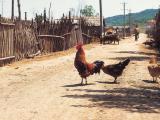The US Department of Agriculture (USDA) Animal and Plant Health Inspection Service (APHIS) last night announced that it has shared 239 recent genetic sequences of the H5N1 avian flu virus from poultry, wild birds, and dairy cows, which will help scientists look for new clues about the spread of the virus.
In related developments over the past 3 days, APHIS reported four more H5N1 detections in dairy herds, along with more positive findings in wild birds and poultry. Also, the Centers for Disease Control and Prevention (CDC) posted a recent update on its actions to look for new human infections.
Eagerly awaited genetic sequences
As the outbreak nears the 1-month mark, it's still not known how the 2.3.4.4b H5N1 clade is now able to infect cows and exactly how it is spreading in dairy herds. With the virus still spreading across multiple world regions, veterinary experts are looking for answers to protect dairy cows and human health.
Some scientists have voiced frustration with the slow pace of sharing genetic sequences and other investigation details. Until yesterday, only a few genetic sequences were available from the recent outbreaks, including those from a few cows and cats that were detailed in a recent preprint paper from a team at Iowa State University.
In its statement, APHIS said it usually publishes sequences on GISAID, the Global Initiative on Sharing All Influenza Data, but for transparency and to speed research, it shared raw sequence data via the National Institutes of Health National Center for Biotechnology Information. It added that the sequences are from cattle, cats, chickens, skunk, racoon, grackle, blackbird, and goose and that it will continue to make the data available on a rolling basis.
Louise Moncla, PhD, assistant professor of pathobiology at the University of Pennsylvania School of Veterinary Medicine, today on X welcomed the posting of the raw genetic sequencing, but said analysis steps such as downloading and mapping will take time, and it will take a while before scientists can show how the viruses are related to each other.
More detections in cows, poultry, wild birds
Meanwhile, in updates over the last few days, APHIS reported 4 more H5N1 detections in dairy herds, which raise the total to 32. The latest positive samples were from cows in Kansas, Michigan, and Texas.
Also, APHIS reported two more H5N1 detections in poultry flocks, including an earlier announced outbreak at a commercial turkey farm in Michigan's Newaygo County and a third hatchery in New Mexico's Roosevelt County. The agency also reported about 30 more H5N1 detections in wild birds, including waterfowl, shorebirds, crows, and raptors. Most were from the eastern part of the country.
Virus susceptible to neuraminidase inhibitors
In other related developments, the CDC on April 19 posted an update in its response, which includes lab studies to better clarify the impact of antiviral drugs and candidate vaccine viruses.
The agency said it just completed susceptibility testing for seasonal flu antivirals. Tests on the H5N1 virus from the recent human case in Texas confirm that it is susceptible to all commercially available neuraminidase inhibitors. "Testing to confirm susceptibility to baloxavir marboxil, a different antiviral medication, takes longer and is ongoing," it said.
Testing to confirm susceptibility to baloxavir marboxil, a different antiviral medication, takes longer.
The CDC said it is studying blood samples from people to have been vaccinated against H5 avian flu to confirm that existing candidate vaccine viruses (CVV) protect against the H5N1 virus isolated from the patient in Texas. Earlier genetic analysis suggested that the CDC's two existing CVVs would protect against the subtype found in the Texas patient.
Among other actions, the CDC said it is designing an epidemiologic field study to better understand the outbreak. So far, its monitoring of emergency department and flu testing data in areas where H5N1 has been found in dairy cattle or other animals shows no unusual trends.



















